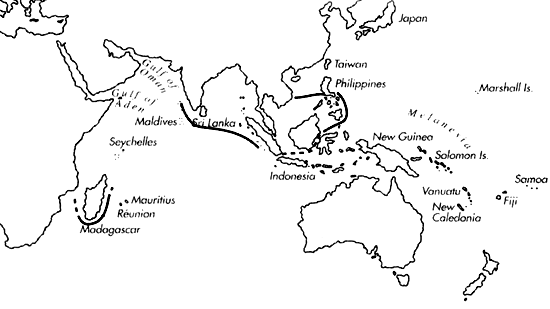
Skip Navigation Links
View access keys for this site.

Range: S. India, Andaman Sea, Malaysia, and Indonesia to Philippines; probably also in Solomon Is. and Madagascar.
Description: Medium-sized to moderately large, moderately solid; form straturatus (Pl. 39, Figs. 13, 14) smaller. Last whorl ventricosely conical to conical; outline convex adapically, less so or straight below; left side usually slightly concave near base. Shoulder angulate to subangulate. Spire of low to moderate height, outline concave. Larval shell of 2-2.5 whorls, maximum diameter 0.7-0.8 mm. Teleoconch sutural ramps flat to slightly concave, with 2 increasing to 3-8 spiral grooves that contain additional spiral striae and threads in latest whorls. Last whorl with widely spaced spiral grooves on basal third to half, to shoulder in subadult specimens and in adults of some populations; broad interstitial ribbons split into ribs toward base.
| Shell Morphometry | ||
|---|---|---|
| L | 35-60 mm | |
| (-form straturatus 29-34 mm) | ||
| RW | 0.10-0.24 | |
| (L 60-52 mm) | ||
| RD | 0.53-0.60 | |
| PMD | 0.80-0.90 | |
| RSH | 0.09-0.18 | |
| (-form straturatus 0.09-0.12 mm) | ||
Ground colour white. Last whorl with axially and spirally confluent yellowish brown to brown spots and flecks, forming interrupted to continuous spiral bands below shoulder, above centre and within abapical third. Remaining areas sparsely to heavily maculated with spiral rows of brown dots and dashes. Base white to pale brown, sometimes dark violet. Apex white to brown, sometimes grading from white to brown. Late sutural ramps with yellowish brown to dark brown radial streaks and blotches. Aperture white, purple or violet.
Habitat and Habits: In 50- 100 m.
Discussion: C. inscriptus differs from C. collisus primarily in its last whorl colour pattern of regular spiral rows of brown or orange dots, spots, bars or axial streaks, rather than a more irrregular pattern of axially and spirally confluent brown spots and flecks. The first 2-4 postnuclear teleoconch whorls of C. inscriptus are weakly to strongly tuberculate rather than smooth as in C. collisus. C. blanfordianus differs from C. collisus in its rather conoid-cylindrical last whorl (PMD 0.76-0.83 vs. 0.80-0.90) with an aperture that is markedly wider at the base than near the shoulder, and its last whorl pattern with about 15 rows of brown spots and bars. C. collisus is also similar to C. andamanensis, C. subulatus, C. broderipii, C. sertacinctus and C. stramineus; for distinctions from those species, see their Discussions. C. collisus is remarkably variable in shape and colouration, even within the same area. Specimens agreeing with the descriptions of C. nisus and C. kieneri (Pl. 39, Figs. 10- 12) have a rather conical last whorl and rather dark violet aperture; this form occurs in W. Thailand and probably in Madagascar. C. stigmaticus (Pl. 39, Fig. 9) corresponds so closely with C. collisus that it must be considered as a synonym. C. straturatus (Pl. 39, Figs. 13,14) was described from 3 shells somewhat smaller than those of adult C. collisus but otherwise corresponding closely with the latter. The pattern of their last whorls consists of brown flecks forming a spiral band below shoulder, above centre and within basal third: dashed and dotted darker brown spiral lines overly these bands.

C. collisus range map
This section contains verbatim reproductions of the accounts of 316 species of Conus from the Indo-Pacific region, from Manual of the Living Conidae, by Röckel, Korn and Kohn (1995). They are reproduced with the kind permission of the present publisher, Conchbooks.
All plates and figures referred to in the text are also in Röckel, Korn & Kohn, 1995. Manual of the Living Conidae Vol. 1: Indo-Pacific Region.
The range maps have been modified so that each species account has it own map, rather than one map that showed the ranges of several species in the original work. This was necessary because each species account is on a separate page on the website and not confined to the order of accounts in the book.
Return to framed version (returns to search page)